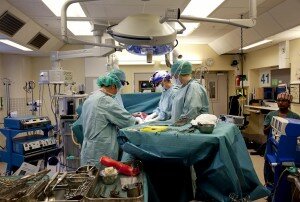
A breakthrough transplant that’s raising Irish hopes – Baby born in the womb of 61-year-old may change need for surrogacy
A woman who has given birth using a transplanted womb is being hailed by Irish doctors treating women who need to use surrogacy to have children.
A baby boy was delivered by Caesarean section last month by Mats Brannstrom, professor of obstetrics and gynaecology at Sahlgrenska Academy, Gothenburg, Sweden
The baby’s mother, a 36-year-old athlete, was born without a uterus but had her own ovaries, which produced healthy eggs. In 2012, she received a uterus from a 61-year-old family friend.
In January, the younger woman was implanted with an embryo created from her own egg and sperm from her partner. Although the baby was premature, he was healthy and left hospital after ten days.
Irish doctors said that the news announced yesterday was incredible’ arguing that it could open the way for women without a womb or whose womb is damaged to give birth. Swedish doctors have been working on this technology for while, but the 36-year-old woman is the first to give birth.
Ray Sullivan, consultant obstetrician at Kilkenny Hospital, said: ‘It is amazing. It’s for a very specific group – women who have had a womb removed because of cancer, or women born without a womb, or have a distorted uterus. They are the ones for whom this offers hope. It is not uncommon for women here to be born without a womb. I’ve looked after women who’ve had to go to India for surrogacy.’
In the UK an estimated 14,000 women have this genetic condition, which may mean there are 1,400 such Irish women. These women can still produce eggs but are unable to carry a pregnancy – something this revolutionary technique could change. Mr Sullivan said that the surgery is not now being developed in Ireland.
Obstetrician John Waterstone, at Cork University Hospital, said: ‘For some women the only option was surrogacy. If they could have a womb transplant then they wouldn’t have to go for surrogacy. That is quite difficult: women have to go abroad, it’s expensive and there have been legal problems.’
He said this operation opens up the possibility of mothers helping their daughters have a child. ‘The other women who’ve had this transplant had the womb from their mother. If a woman has a serious problem, the person most likely to give her a womb is her mother. If this becomes commonplace then mother-to-daughter donations would be common.’
Helen Browne, of the National Infertility Support and Information Group said: ‘It is wonderful – the fact that women would have the opportunity to carry their baby and breast-feed. It wouldn’t have the legal implications or difficulties of surrogacy. Women come to us and might not have a uterus. We have a girl who had a hysterectomy because she had cancer.’ At the moment there are three options for these women: surrogacy, adoption or never having children.
‘This would give them a fourth option. It’s being done abroad so it would be expensive, but in a few years it could be a possibility.’ News of the birth was published in British medical journal The Lancet. Details have been kept under wraps until medics were sure all had gone well. The little boy was born at 31 weeks and weighed 3.9lb. His mother had developed pre-eclampsia – a life-threatening condition.
Six other women are now pregnant through the same groundbreaking project at Gothenburg University. In five cases, the donor was the woman’s mother – so the same womb could now carry two generations of the same family.
Pin It

Google+

Org Medlines
















